The Rough n’ Tumble Genius of the Silent Era Proves to be far More Than a Stonefaced Stuntman
WRITTEN BY DANA STEVENS/ATIRA BOOKS/2022
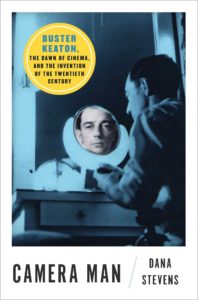
Who was Buster Keaton? Dana Stevens, author of Camera Man: The Dawn of Cinema, and the Invention of the 20th Century, the new biography of the venerable comedy star of a hundred years ago, knows better than to ask that question. Keaton, in his still-popular independently produced slapstick masterpieces of the late silent era, told us exactly who he was. Still later, the largely forgotten studio films he appeared in during his painful decline told us specifically who he wasn’t. And still later, in his retrospective interviews as an older man, he told us who he wanted to be.
Unearthing some magical key to the man, nor dishing fresh dirt onto him, isn’t the point of Camera Man. Rather, Stevens spends her pages contextualizing Keaton in a most fascinating way. Unlike most biographies, she often happily steps back from her subject rather than leaning uncomfortably in. In so, she sees him as not just the fearless performer, deadpan persona, and ambitiously technical filmmaker we know him to have been, but also as a kind of Gump-ian totem traversing the rise of cinema.. but in those same moments, coinciding uniquely with much of the vitality of our previous century. His birth coincides with the dawn of cinema (1895). The start of his monumental solo film career coincides with the birth of modern film criticism (1920). Those are just two of the early, movie-centric ties within Stevens’ much larger tapestry. The analogy only breaks down because Keaton did, with his death in 1966- several decades short of the end of the 20th century.

Stevens structures her book like Keaton structured his films: lively, punchy, and full of surprises. Her tendency to interject herself, lapsing unexpectedly into first person commentary, can be abrupt, though never unwelcome. In the final coda, its semisweet poignancy is enough to validate the usage throughout. Like any true historian, Stevens understands that a fuller comprehension of the world that was is central to a fuller comprehension of the world that is. There are broad stretches of Camera Man in which Keaton is a periphery player, if there at all.
In truth, however, Keaton is always present in spirit; he is Stevens’ inspiration as connective tissue throughout this most covertly unusual of biographies. True to the title itself, the narrative freely sprawls outward from the central protagonist to contextual explorations of the dawn of cinema and fanning out to details of “the invention” of the 20th century itself. That aspect of the title can of course wield a double meaning, insofar as cinema could effectively be argued to be the invention of the 20th century (give or take a few years). If that reading is to be accepted, then it’s no wild stunt to cast Buster Keaton in the central role.
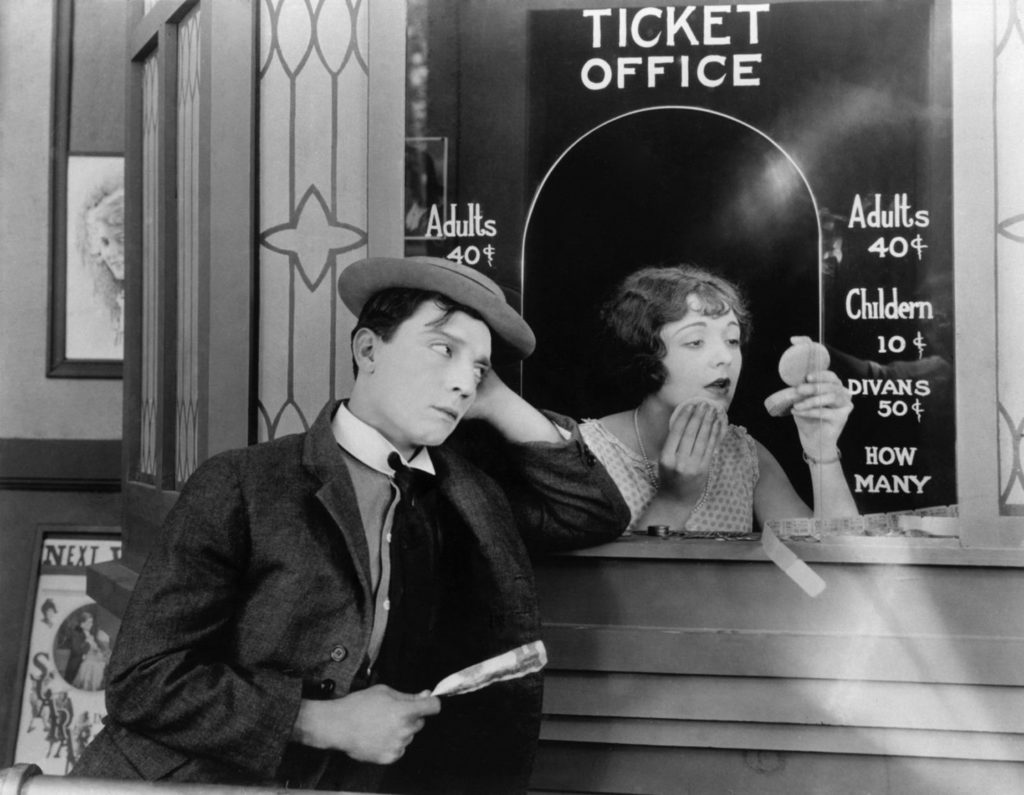
One needn’t have been a picture fan in Keaton’s 1920s heyday to know of the kind of “print the legend” mythmaking that’s defined the performer’s enigma going forward. It began early, with his father Joe regaling local newspapers with tall tales of his popular indestructible young son. The family had a highly successful vaudeville act, the child-endangerment daring-do of which earned the droll little Joseph Frank Keaton the nickname “Buster”. It stuck. Later in life, Buster himself would pick up his father’s schtick, spinning autobiographical yarns in the interest of legacy management.
Though a film critic by day, Dana Stevens puts those inclinations aside in favor of wide swaths of contextualization. A particularly poignant observation arrives in a mid-book chapter that explores Keaton’s reoccurring themes of “home” throughout his work. Namely, dangerous dwellings that have it in for their occupants. (It’s a notion solidly dating back to his first independently directed film, 1920’s home kit-bashing two-reeler, One Week). Stevens, making it seem obvious all along, connects Keaton’s nomadic vaudeville upbringing- in which his own imperviousness was ever the punchline- with his ongoing distrust of permanent residences.
When it was time to grow up, everything changed. Is it true that all in a single fateful day, budding young man Buster Keaton actually met his crucial moviemaking mentor and first on-screen partner, Roscoe “Fatty” Arbuckle, and there and then decided to veer into filmmaking, and also met his first wife? Legend says yes. Stevens, though, maintains a level head, insofar as the real truth is concerned: her implication being, all of those important things did happen; does it really matter if it was all in the same twenty-four-hour span?? What’s likely quite true is that the ever-curious Keaton immediately had to know how that movie camera worked. Legend also then says that he took it home that night, took it completely apart, reassembled it in working order, and had it back on set the next morning. If there’s any truth to that popular anecdote, then Arbuckle and company were clearly very impressed and very trusting of this fellow. Had the camera come back as parts in a bucket or not at all, that would’ve scraped far more than that day’s filming plans.
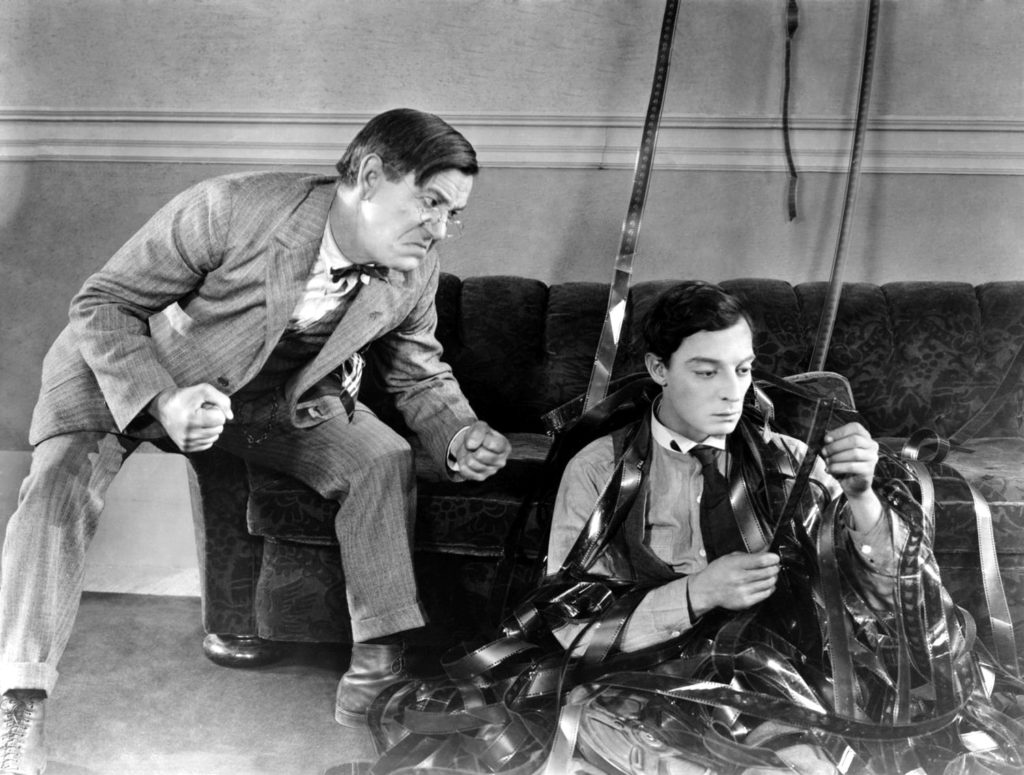
What matters in regard to Keaton’s enduring work is what has and will always matter- his approach to filmmaking. She accurately if perhaps too obviously describes his individual craftsmanship behind the camera as “minimalist” and “action-focused”. The man is remembered for his characteristic expressionlessness, his trademark pork pie hat, and the insane risks he took in his movies. But while those things mark a brand and net notoriety, they do not a genius make. But, as even the most casual fan of silent comedy will tell you, Buster Keaton ranks as one of the “three geniuses” of the very competitive form. Chaplin had the grace and perfect pathos; Lloyd had the everyman appeal and the heart. For the ever-rough n’ tumble Keaton, he would prevail in terms of the technical.
As fate would have it, Keaton was handed a deep-pocketed laboratory where he could realize the stuff of his dreams. Giant boulder avalanches, intricate electric houses, all manner of high speed near misses, and even the demolition of a careening locomotive- all of that and more sprung forth and was successfully realized. It was, unfortunately, all enabled by the scandalous and, as Stevens maintains, wholly unwarranted fall of Roscoe Arbuckle. When Arbuckle’s fully functional comedy studio went up for grabs; it only made sense that Keaton take over. And take over he did. Keaton wasn’t always credited as director, but make no mistake- he ran the show, and everyone knew it. The sign on the roof read “Buster Keaton Studios”. Inside, it would be plenty evident that aspirations ran well beyond concocting new ways for the star to nearly get himself killed on film. (Although what proved to be the topper, the multi-ton house front falling perfectly around him in 1928’s Steamboat Bill, Jr., can’t help but be a narrative flashpoint in a book such as this).
According to Stevens, “Keaton was formally innovative, inclined to puncture social pretension, and given to making art that was, in a uniquely 1920s way, sardonic and romantic at once.“ Indeed, just as Keaton is swallowed up only to be taunted by the film form itself in Sherlock Jr., he would become the victim of his own cinephilia. (Cast as an unspeaking Sunset Blvd. “waxwork”, no less). After the 1920s, he would be primarily a victim far more than the beneficiary of the art form that he helped solidify. (Though, in his later years, he claimed not to see it that way, referring to himself as “fortunate” and his career arc as ideal).
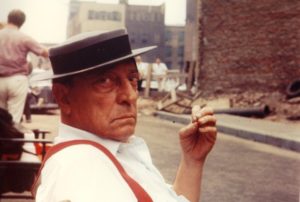
But, even well before his inglorious and beaten fall to alcoholism and several failed marriages, Keaton’s worldview was imbued with knowing cynicism. Regarding one of his earliest shorts, 1920’s Cops, Stevens observes: “The cosmos of Cops is a place of random injustice and meaningless violence, where valor, industry, and even true love go unrewarded.” No one used the word “auteur” like we do now- Keaton himself likely would’ve recoiled at it- but his auteur fingerprints are all over his filmography from the get-go.
Full-on veneration, nor, heaven forbid, apology, is in no way on the agenda of Camera Man. Stevens is very interested in charting her subject’s transgressions, cinematic and in real life, just as she is his achievements. As far as Keaton’s pictures are concerned, acknowledgment of the ever-morphing nature of stand-out social inequalities garners considerable ink. In other words, things that rankle audiences today are not at all what rankled them 100+ years ago. 1925’s frantic race to marriage, the box office triumph Seven Chances, is, for its overt racism (including his use of blackface), declared Keaton’s most quantifiably problematic film. Stevens then takes the film to task in a blow-by-blow manner.
Likewise, today’s go-to Keaton “masterpiece”, 1926’s then-train wreck The General is demoted over the course of several pages. This is not Buster Keaton being targeted in the name of “wokeness”, or whatever accusatory handwringing that defensive individuals run to. This is simply history, as black, white, and mostly grey as the films themselves. Again, this is Keaton as an allegorical surrogate/springboard for the (American) twentieth century- in all its glory, tatters, and shame.
Stevens freely and frequently deviates her focus on other important individuals in pages-long mini-biographies within the biography. Such tangents include breakthrough comedian and director Mable Normand, auto tycoon Henry Ford, the development of child protective laws in the U.S., and playwright and presidential speechwriter Robert Sherwood. The latter proved to be the most vocal early appreciator of the art of Buster Keaton. Circa 1923, he rhapsodized: “He [Keaton] can attract people who would never think of going to a picture palace to see anyone else. Moreover, he can impress a weary world with a vitally important fact that life, after all, is a foolishly inconsequential affair.“
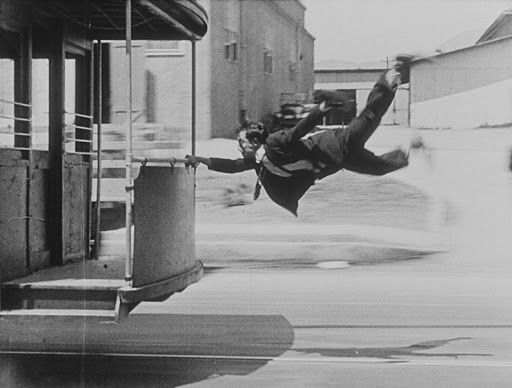
But for Keaton, was it really? Stevens, for all her unapologetic side roads and terrific tangents, seems to make the argument that despite chronic unhappiness and more years of toil than of triumph, it couldn’t have been inconsequential. (If it were, why a book?) Well into reading Camera Man, having become accustomed to the author’s detours, a most strange realization occurs… that we’ve actually spent a lot of time with Buster Keaton.
Camera Man rounds out just as it roundabouts, which is, impressively well. As long as The Movies matter (the foremost invention of said twentieth century), so too will Buster Keaton. And, as long as historians remain curious and diligent, contextualization will (and must) continue- no matter how many books on the topic are published.
As we eventually accompany Stevens to Keaton’s grave, the mandatory, well-tread territories of the ol’ St. Bernard’s lore are of course covered and reiterated- Buster the visual effects genius; Buster the fearless stuntman; Buster the fallen genius- as they no doubt are in another Buster Keaton book dropping concurrently with this one. Stevens’ gift, though, is in the sowing of connective seeds as she takes the scenic routes in “the invention of the 20th century”. We come to find that her sprawl outward from Keaton in fact gives way to multiple roads inward. His story, as unique and painful as it can be, isn’t just a springboard to a Bigger Picture. It’s a natural roadmap.

